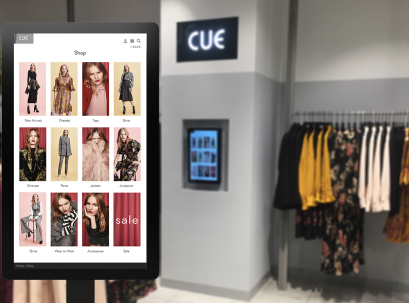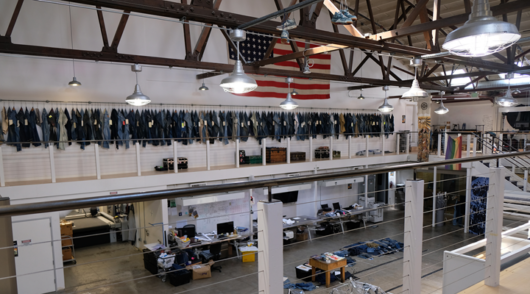 Like many Australian retailers, Cue Clothing Co. has been on a journey in recent years to create a more seamless shopping experience. Just don’t call it an omnichannel retailer.
Like many Australian retailers, Cue Clothing Co. has been on a journey in recent years to create a more seamless shopping experience. Just don’t call it an omnichannel retailer.
Late last month, Cue unveiled shoppable screens in five flagship stores that give customers access to the brand’s entire inventory through an ‘endless aisle’ concept.
Customers can now shop any style, even if it is not in stock at a particular store, and pick up purchases at a nearby store that does have it in stock, or have the item delivered to their preferred address in as little as three hours.
The retailer plans to roll out shoppable screens in all stores in future, as it continues along the path to integrate its bricks-and-mortar and online offerings into a seamless shopping experience for customers. Since launching a click-and-collect service 18 months ago, Cue has also added a store-to-door fulfilment option with same-day delivery where possible.
This reflects the fact that it is no longer enough to simply operate a store network and an e-commerce site. Retailers today must provide a consistent offering and experience across every sales channel on the front end and bring together data from every touchpoint in a central location on the back end.
“We’ve been on a journey over the last four to five years of really trying to bring our sales channels closer together and trying to connect our website and digital channels with our stores,” Shane Lenton, chief information officer at Cue, tells IRW.
By all accounts, Cue’s efforts are paying off. According to Lenton, e-commerce now represents more than 20 per cent of the company’s overall sales, with around 30 per cent of online sales being fulfilled through click-and-collect in any given week.
“The cost of rent, fitouts and wages at a store level aren’t going away,” Lenton points out.
“But we’ve been able to capitalise [on our physical footprint] by growing digital channels, and we’re seeing a great return on investment [from click-and-collect].”
Cue’s endless aisle initiative is also paying dividends. Because the retailer doesn’t mass produce items, it doesn’t stock every style in every store and doesn’t carry a lot of depth in sizes. In the past, if a customer wanted to buy an item that wasn’t in stock, the store would have to transfer it from another location, call the customer when the item arrived and hope they returned.
“Historically, we wouldn’t have converted around 70 per cent of those transfer situations,” Lenton says. “Now we absolutely capture the sale there and then. That’s had a major impact on our business from a bottom line perspective.”
So far, so successful. But perhaps the most interesting thing about Cue’s transformation is that – internally, at least – the word omnichannel is nowhere to be heard. Instead, over the past year, the retailer has shifted to what it calls a ‘unified commerce’ approach.
A unified approach
The difference, according to Lenton, is that omnichannel involves pulling together several siloed systems with at-times cumbersome integrations, while unified commerce is all about replacing those bolted-on solutions and maximising one core platform to support the bulk of operations across channels.
“The reason unified commerce resonated with me is that it focuses on one having core platform do the heavy lifting and having a single source of truth to manage the customer, order orchestration and everything, rather than relying on too many systems to push and pull data everywhere,” he says.
Lenton says having one core platform has allowed Cue to do things like remove buffers to make products available online or through click-and-collect down to the last item and let customers choose a different fulfilment option for each item in an order.
Cue has primarily worked with Triquestra to build out its retail management system, though Lenton concedes there will always be a place for best-of-breed solutions. For instance, the retailer is partnering with FoyerLive on shoppable screens and other in-store technologies, uses Shippit for fulfilment and offers Afterpay at checkout.
Still, he thinks one of the reasons omnichannel hasn’t been the silver bullet some retailers were hoping for, has to do with a fundamental lack of consistency on the back end.
“A lot of established retailers are potentially struggling with legacy systems, having bolted on solutions for the digital space…that’s where the challenges lie now,” he says.
 While Pippa Kulmar, co-director of Retail Oasis, hasn’t heard of many retailers adopting a unified commerce approach, she agrees that omnichannel as a concept is coming under greater scrutiny, as e-commerce giants like Amazon and Alibaba demonstrate what is possible.
While Pippa Kulmar, co-director of Retail Oasis, hasn’t heard of many retailers adopting a unified commerce approach, she agrees that omnichannel as a concept is coming under greater scrutiny, as e-commerce giants like Amazon and Alibaba demonstrate what is possible.
“The term being thrown around at the moment, thanks to Amazon, is frictionless retail,” Kulmar tells IRW.
“Instead of a term like multichannel or omnichannel or unified commerce, which is internal-facing and telling the business, ‘Come on guys [departments], work together’, frictionless retail is external-facing. It’s about identifying the pain points in the customer journey and asking the business, ‘How can we solve them using technology, online, staff?’,” she says.
“The current issue I see in retail is that we talk about omnichannel because we still see the channels as separate. If you can get into the shoes of the customer, you’ll [realise] all they see is the brand, not the channels.”
All in good time
A key aspect of Cue’s transformation is the time it has taken to bring initiatives like click-and-collect and endless aisle to market. Lenton, who oversees the IT, digital and CRM teams at Cue, says he has occasionally pushed back against the business to wait and roll out a better, more comprehensive solution, rather than launch something just for the sake of it.
“Our philosophy has always been to build the right foundations from the start, rather than looking to race ahead with innovation,” he says.
“Even when there were opportunities to be first-to-market, we took the approach of getting the foundations right, which is enabling us to really accelerate now.”
While this has certainly benefited the customer, it has arguably been even more advantageous for Cue. Lenton recalls that the first retailers to roll out click-and-collect around 2014 and 2015 were still fulfilling many of those orders from distribution centres, rather than stores, and therefore not realising all the potential cost savings.
Since Cue launched its own click-and-collect offering 18 months ago, Lenton says the vast majority of orders are fulfilled from stores. The retailer over the years has also come up with some elegant solutions for in-store staff to see the benefits of e-commerce sales.
Working with Triquestra, Cue tweaked its returns verification process to push back refunds and exchanges to the original sale location, so stores no longer had to carry the negative impact from online returns.
And before rolling out its store-to-door solution, the retailer found a way to incentivise multiple teams for fulfilling an order – since one store provides the customer service and completes the transaction, while another store packages the order and marks it ready for delivery – without making it difficult for the finance team to attribute the sale.
Lenton adds that Cue has been able to do all of this without putting on additional staff or increasing its overheads, largely thanks to its strategy of building out one core platform as the single source of truth.
“We don’t have to run secondary reports, it’s completely automated. And that’s possible because of the unified commerce platform we’re using.”





